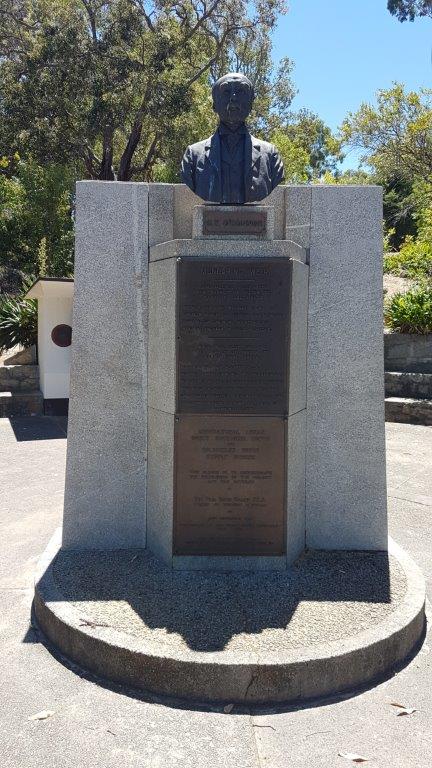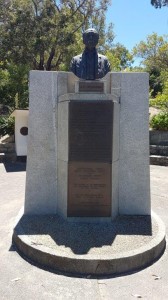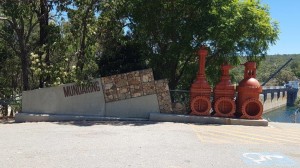A Scheme of Madness – Words do kill!

 Words are powerful! They create and they destroy, a great reason why we need to pick them carefully. This week I had the opportunity of visiting Mundaring Weir. Here I got reminded of how important our tongues are. As I leaned on the rails that run across the weir, I couldn’t but think deeply about how one great Engineer was driven to commit suicide by words.
Words are powerful! They create and they destroy, a great reason why we need to pick them carefully. This week I had the opportunity of visiting Mundaring Weir. Here I got reminded of how important our tongues are. As I leaned on the rails that run across the weir, I couldn’t but think deeply about how one great Engineer was driven to commit suicide by words.
An hour and some few minutes’ drive, east of Perth is Mundaring Weir. To many Western Australian, Mundaring Weir is a significant landmark in the state. It was here that a remarkable feat of engineering was conceived and executed by C.Y. O’Connor. To date, this work that is nearly a century old still hold its record in the annals of Engineering.
The late 17th century gave Western Australia a unique present and at the same time a unique challenge as well. In 1892, gold was found in Coolgardie and a year later in Kalgoorlie in commercial quantities. With these discoveries, there was a gold rush leading to an influx of people into this arid interior of the state. All looked good, except there was a problem. Despite the abundance of gold, there was no water. We know that water gives life but the goldfields were dry and water was absent. Some ingenious men decided to solve the problem by importing Camels from Afghanistan. The Camels were put to work in taking water from Perth to Karlgoorlie. We all could guess how well this went, not enough volumes of water were being transported to sustain the human habitation and an alternative needed to be found.
It was to C.Y. O’Connor that the then Premier of Western Australia, John Forrest, turn. His instructions to the recently immigrated Irish man was for him to come up with a way to get water to the goldfields. C.Y, not being one to shy away from responsibility, no matter how arduous, took up the gauntlet and went to work. His proposed solution was to take five million gallons of water from the Perth Hills daily, pump this up for almost 1,200 feet and out over the plains for 350 miles till it gets to Kalgoorlie. Too good to be true many will say and for those bold enough, they called it the scheme of madness! Well, let us not forget that this was the late 1890 and technology was not what it is now. So, they were probably not crazy to think that way.
 On paper, C.Y’s idea was simple. First, they would dam the lower Helena River at Mundaring and create a Weir. Then would lay the pipes and boost the rate of water flow using pumps placed at intermediate points on the pipeline route. Nothing complicated. The complications came from the state of development of Western Australia as at then. Firstly, Western Australia didn’t have the capability to manufacture the pipes. Secondly, the infrastructure to move the pipes across the vast isolated and hostile terrain was absent. Lastly, there was a dirge of Capital. Capital, given its alternate uses, was scarce. Investing this scarce resource to develop the Goldfield Water Pipelines meant forgoing some other critical government funding needs.
On paper, C.Y’s idea was simple. First, they would dam the lower Helena River at Mundaring and create a Weir. Then would lay the pipes and boost the rate of water flow using pumps placed at intermediate points on the pipeline route. Nothing complicated. The complications came from the state of development of Western Australia as at then. Firstly, Western Australia didn’t have the capability to manufacture the pipes. Secondly, the infrastructure to move the pipes across the vast isolated and hostile terrain was absent. Lastly, there was a dirge of Capital. Capital, given its alternate uses, was scarce. Investing this scarce resource to develop the Goldfield Water Pipelines meant forgoing some other critical government funding needs.
Undaunted, C.Y. O’Çonnor started in 1898. In their very eyes, the plan started being transformed to reality. The work to dam the Helena River began. Little by little, the retaining wall started to emerge from the river bed as a concrete mountain. Then the pipes started arriving and then the coupling work started, preceded by the bush clearing to provide the pathway for the pipeline over its 530km length. It didn’t stop there. They had to build the pumping station. The first one got erected at Mundaring and was aptly named Pump No. 1. There would be seven more to come.
Loan had been taken from Britain but what was advanced was not enough to meet the budget. Unperturbed, C.Y diligently faced the work he had in front of him. He was convinced that it was better to start with the funds available and somehow, the funds to complete the project would be found. Soon funds dried out but the project was far from finishing. “Kill him, crucify him”, the cacophony of voices were loud. Since they did more to Jesus, C.Y. a mere mortal was not moved. He shrugged them off.
 Instead of the criticism waning it got louder and soon developed a life of its own. The bombardment was daily and it came from all fronts, the parliament, the press and the public. They were unfounded, they were unjust but no one cared. Let’s kill this project and its messiah before it bankrupt our state was all they were interested in doing. The criticisms soon got through his Irish skin. First they took his sleep away. What followed had him questioning his normalcy. At this stage some who knew him could see that he was no longer himself. Their “scheme of madness” had become a self-fulfilling prophecy, the architect of the scheme was running mad. No mental health help was available, he was left to himself. He did what came right to him, he needed to end it all and take himself out of his misery. A bullet to his head did the trick and he was gone to care less no more. This was 1902.
Instead of the criticism waning it got louder and soon developed a life of its own. The bombardment was daily and it came from all fronts, the parliament, the press and the public. They were unfounded, they were unjust but no one cared. Let’s kill this project and its messiah before it bankrupt our state was all they were interested in doing. The criticisms soon got through his Irish skin. First they took his sleep away. What followed had him questioning his normalcy. At this stage some who knew him could see that he was no longer himself. Their “scheme of madness” had become a self-fulfilling prophecy, the architect of the scheme was running mad. No mental health help was available, he was left to himself. He did what came right to him, he needed to end it all and take himself out of his misery. A bullet to his head did the trick and he was gone to care less no more. This was 1902.
Then came January 1903, John Forrest stood at Kalgoorlie, turned a valve and water poured. Magic? No, Engineering. The work was completed and it put the camels to rest. They were abandoned and they went feral. Oh, as to the detractors, they started singing a new song. Hail, our Messiah, Hail C.Y. Alas, he was long gone and their praises couldn’t undo what had been done.
Today, billions of gallons of water had been pumped from Mundaring to Kalgoorlie. As I stood at the Weir, I pondered on how the words of mere mortals terminated a budding life at 59. He was denied the opportunity of carrying his grandchildren. He was denied the glory that should attend his long hours of painstakingly designing and building the pipeline. It could be said that he was driven to commit suicide by their words.

